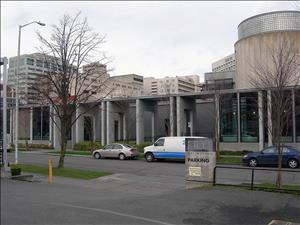On February 8, 1952, the Frye Art Museum, located at 704 Terry Avenue on Seattle's First Hill, opens. The wills of the meatpacker Charles Frye (1858-1940) and his wife Emma (Lamp) Frye (d. 1934) establish the private art museum. They direct their executors to create a free public museum to exhibit their collection of mostly nineteenth-century German Romantic paintings. Paul Thiry (1904-1993) designed the museum building.
The collection has expanded since then, beginning with the acquisitions of the first director, Walser Greathouse (d. 1966). But the abiding rule has been to stick with realism. No abstraction here.
After Walser's death, his widow Ida Kay Greathouse ran the museum for 28 years. Regina Hackett writes that she became famous "for her shrewd management of the museum's finances as well as her outspoken and reactionary views in both art and politics."
The museum was redesigned in 1997, and reopened with its first professional leadership, led by Richard West. Attendance reached more than 100,000 a year in 2001.
The old Frye Art Museum was anti-feminist and collected few women artists. West has changed all that and nearly half of solo exhibitions are of work by women. Recent acquisitions include an Alice Neel ink drawing.
Other artist included in the collection are Pierre Auguste Renoir (1841-1919), Camille Pissarro (1839-1903), Winslow Homer, N. C. Wyeth and his relatives, Marsden Hartley, Maurice Prendergast, Alfred Maurer, Mark Tobey, Edmond Fitzgerald, Doris Chase, William Cumming, Thomas Eakins, Thomas Hart Benton, George Bellows, Ralph Blakelock, John Sloan, Reginald Marsh, John Marin, and the Seattle painter Eustace P. Ziegler (1881-1969).

